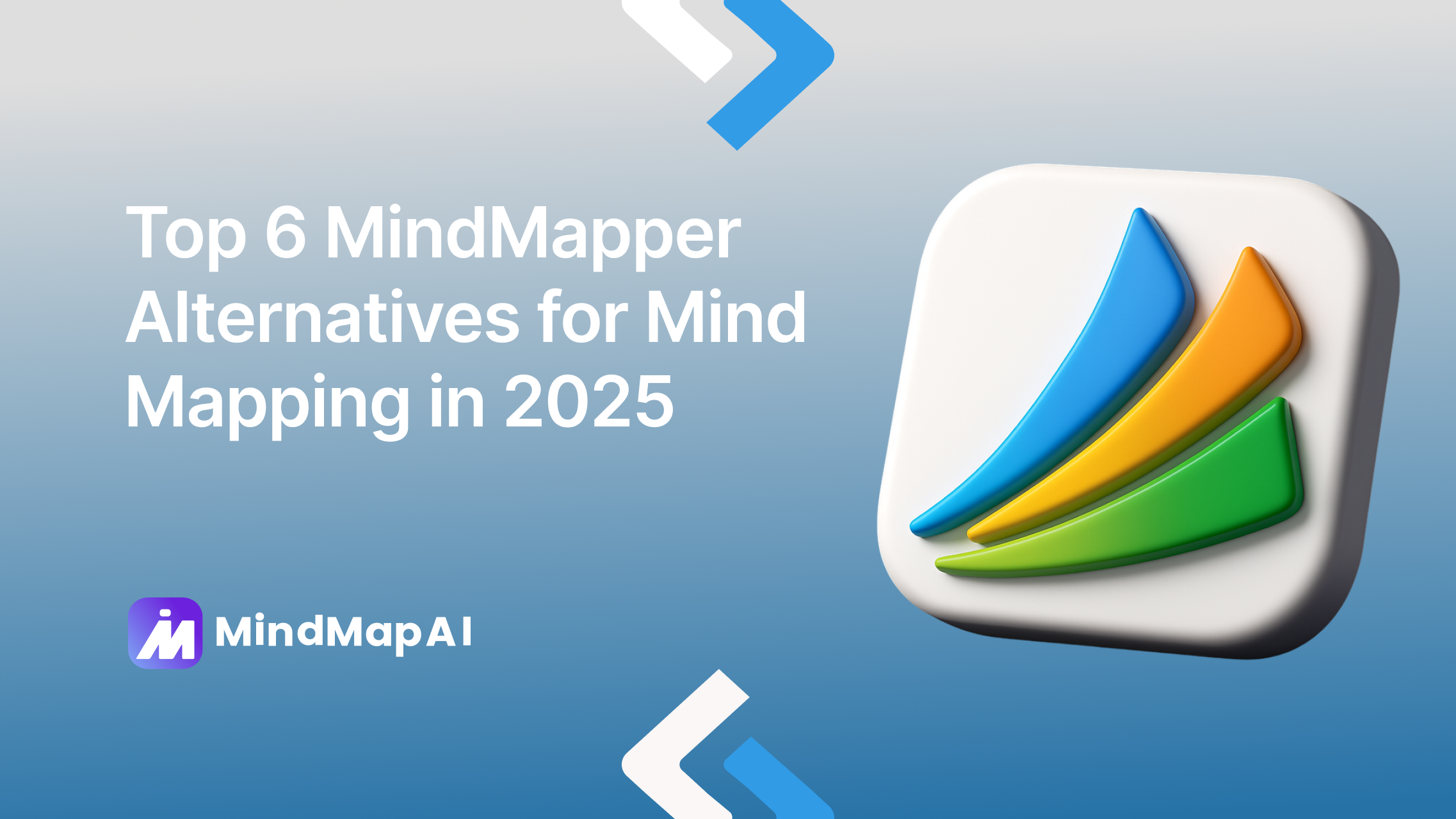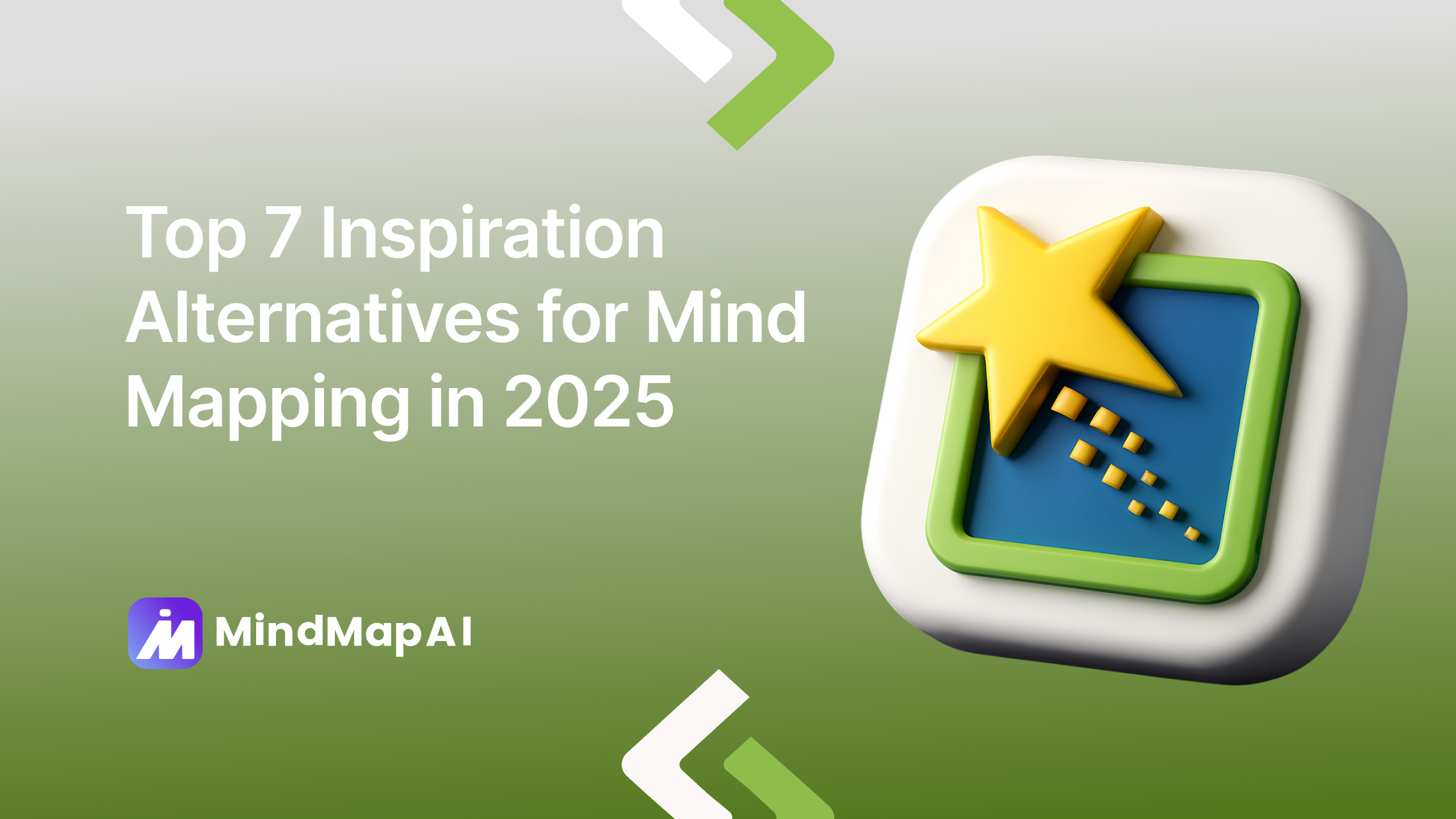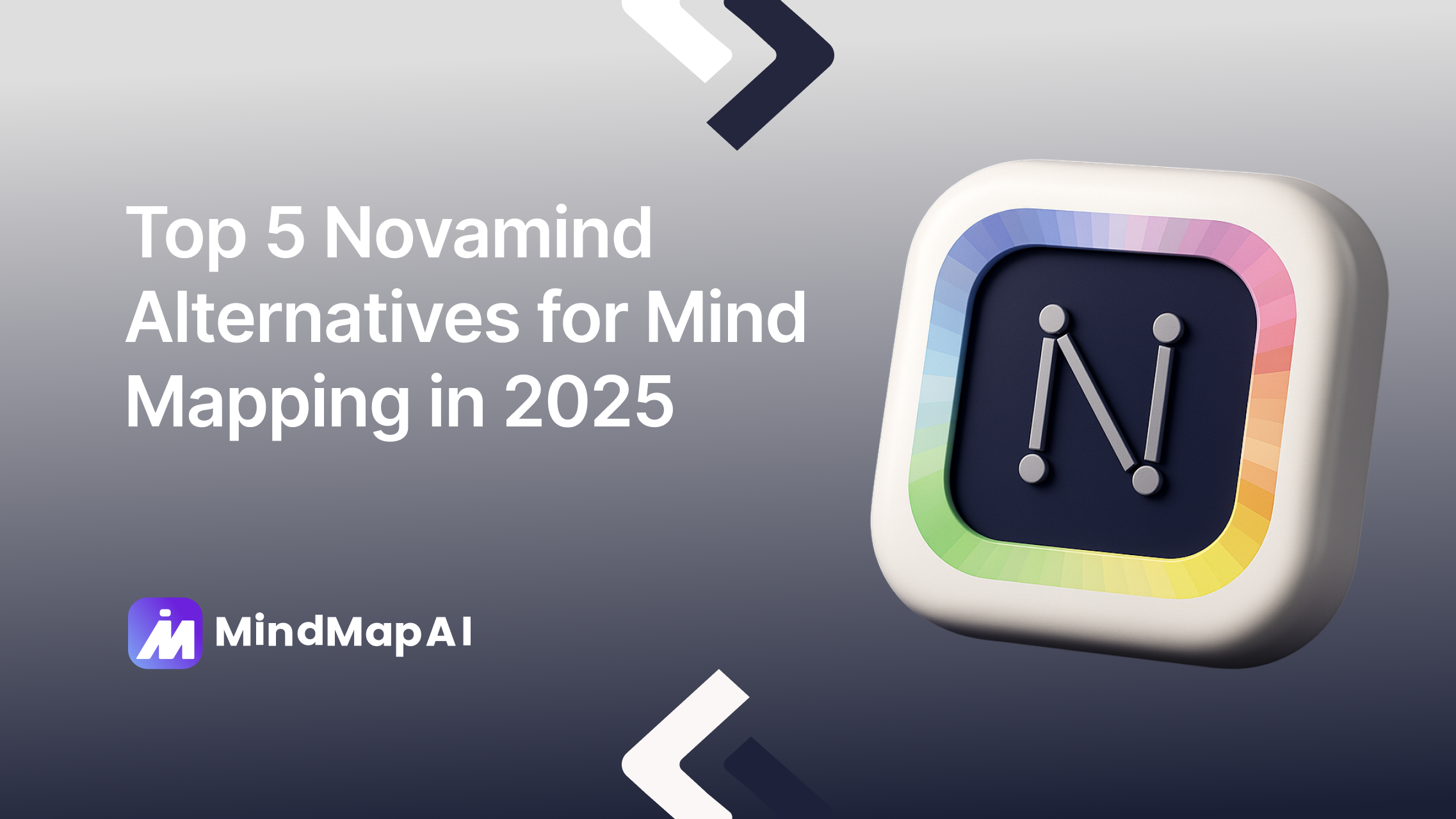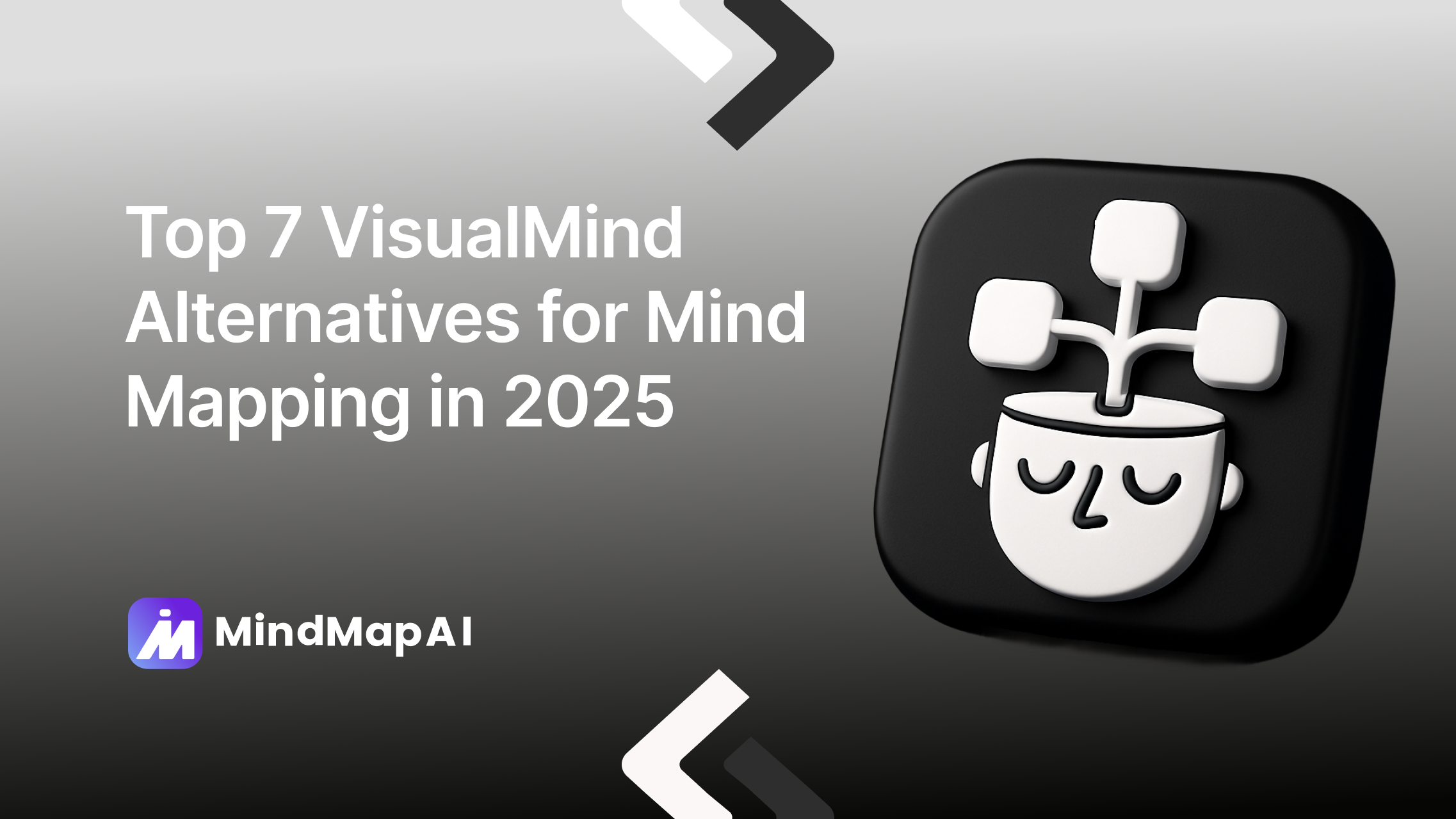
Top 6 VisualMind Alternatives for Mind Mapping in 2025
VisualMind is an emerging AI-powered mind mapping platform designed to help users visualize anything from learning goals and travel plans to business strategies and creative projects. It uses artificial intelligence to transform ideas into structured visual maps, helping learners and professionals think more clearly, retain information faster, and act with purpose.
While VisualMind stands out for its simplicity and AI-driven prompts, some users may want more control, deeper customization, or multi-format input options such as PDFs, videos, and audio. As mind mapping evolves, newer tools are integrating richer AI models, advanced summarization, and real-time collaboration features that go beyond VisualMind’s current capabilities.
This guide explores the best VisualMind alternatives for 2025, AI-powered tools that elevate brainstorming, learning, and project planning through automation, creativity, and intelligent visualization.
Turn your ideas into an AI mind map in seconds
1. MindMap AI

Why it stands out
MindMap AI is the only AI-first mind mapping tool among its competitors that delivers real-time, interactive brainstorming. Users can upload PDFs, CSVs, videos, audio, images, or plain text and instantly generate a structured, editable mind map. Its Copilot Chat understands natural-language commands, while Second-Order Connections automatically surfaces hidden relationships between nodes to deliver deeper insights faster. MindMap AI supports manual editing, multi-format ingestion, and advanced export options, making it perfect for research, education, product planning, and team collaboration.
Key Features
Multi-format ingest: Generate mind maps from PDFs, videos, audio, images, CSVs, and text.

Copilot Chat: Interact with AI to expand, summarize, and focus on ideas using natural language commands.

Second-Order Connections: Automatically discover cross-links between nodes for a deeper understanding of your map.

Sharing & Export: Public/private links, export as PNG, SVG, PDF, Markdown, or CSV.

Version history & cloud storage: Track changes and access maps anytime.
Pros
AI-powered assistance: Drive dynamic brainstorming.
Flexible pricing: Monthly, yearly, and lifetime plans.
Free plan: Unlimited manual maps, watermark-free exports, and version history.
Cons
No real-time co-editing: collaboration via shared links only.
Pricing
Free: 100 AI credits/month
Basic: $3.74/month (yearly) or $7.49/month (monthly) - 2,000 AI credits
Pro: $7.49/month (yearly) or $14.99/month (monthly) - higher AI credit allowance
Add-on credits: From $4.99
Lifetime plan: One-time purchase available
Discover how MindMap AI stacks up against VisualMind
2. Xmind

Why it stands out
Xmind is a versatile, professional-grade mind mapping tool that balances visual clarity, structure, and collaboration. Unlike VisualMind, which is more web- and AI-centric, Xmind emphasizes robust visualization, structured layouts, and cross-platform availability, making it ideal for professionals, students, and teams who need both clarity and flexibility.
It supports multiple map structures such as mind maps, Gantt charts, fishbone diagrams, and organizational charts, allowing users to manage projects, analyze cause-and-effect relationships, or present workflows efficiently. With cloud syncing, teams can collaborate in real time, while local desktop apps provide offline reliability. Its Outliner and Pitch Modes make transitioning from brainstorming to presentation seamless, and Zen Mode allows focused thinking without distractions.
Key features
Multi-structure layouts: mind maps, Gantt charts, org charts, fishbone diagrams.
Cross-platform support: Windows, macOS, iOS, Android.
Real-time collaboration via cloud syncing.
Outliner mode for linear thinking and Pitch Mode for presentations.
Rich template library to accelerate map creation.
Pros
Works across multiple devices and platforms.
Advanced visualization and project management features.
Templates and presentation modes save time and improve clarity.
Local-first storage ensures privacy while offline.
Cons
No AI-powered mapping or automatic content ingestion.
Subscription pricing may be high for users needing full functionality.
Collaboration less seamless than web-first, fully online alternatives.
Pricing
Free: Limited maps and features.
Pro: $79/year for full feature access.
Business: Custom pricing (contact for details).
3. MindNode
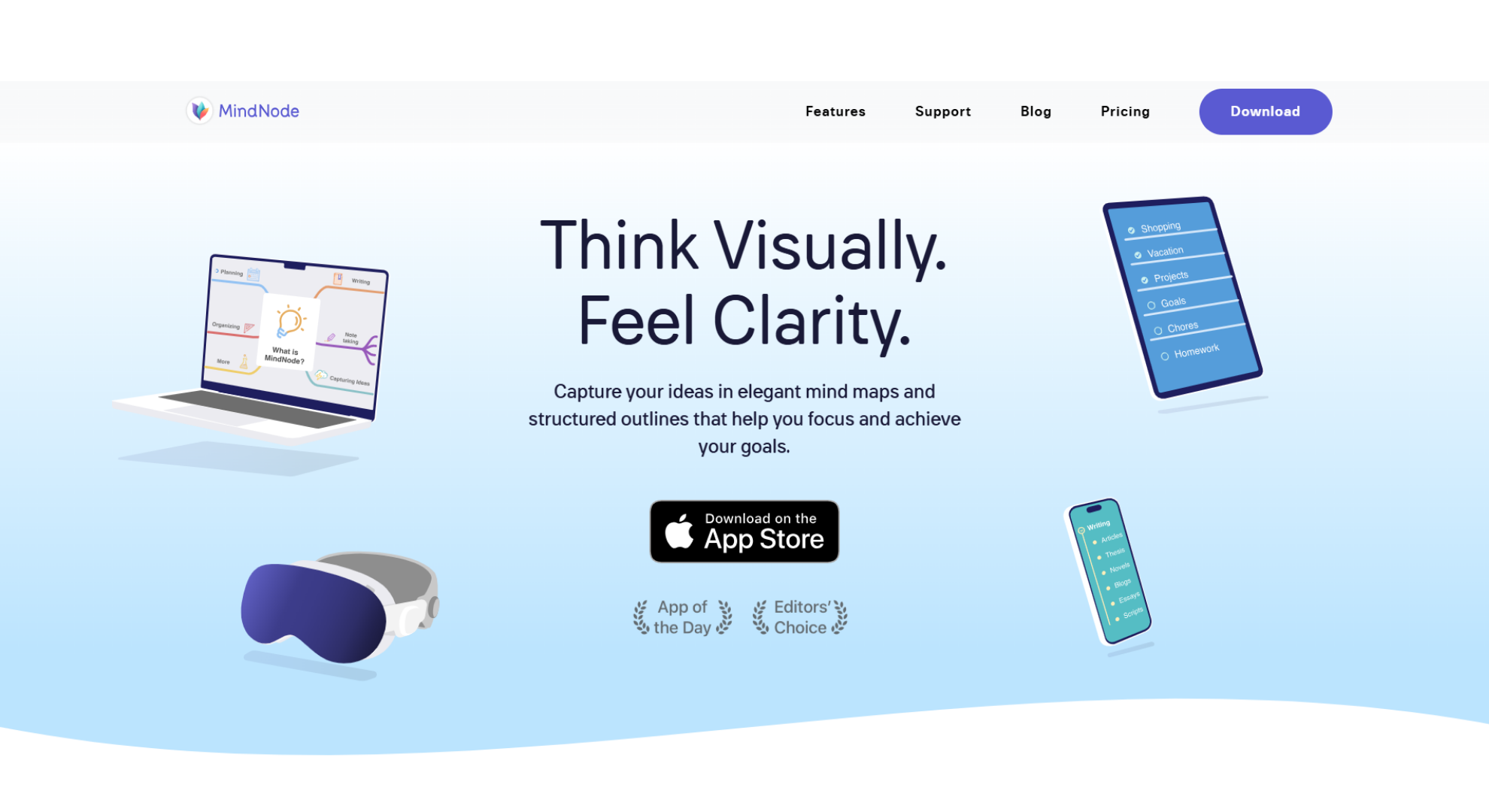
Why it stands out
MindNode is a highly polished, Apple-exclusive mind mapping tool tailored for writers, creatives, and thinkers who value simplicity, elegance, and seamless ecosystem integration. Unlike VisualMind, which emphasizes AI-driven features and web-first workflows, MindNode prioritizes focused, distraction-free thinking. Its Outline to Map workflow lets users switch effortlessly between structured linear views and visual node-based maps, making it ideal for essay planning, brainstorming, or project organization. The Focus Mode allows one node or branch to be highlighted, minimizing distractions and improving concentration.
iCloud syncing ensures your mind maps stay updated across iPhone, iPad, Mac, and Vision Pro devices, while offline support allows uninterrupted work anywhere. MindNode also provides a library of visual tags, stickers, and customizable themes to keep maps engaging and visually intuitive.
Key features
Outline ↔ Map workflow for both structured and visual thinking.
Focus Mode to concentrate on a single branch or topic.
iCloud sync for seamless Apple ecosystem integration.
Customizable themes, visual tags, and over 250 stickers.
Offline support across all Apple devices.
Pros
Beautiful, distraction-free interface optimized for Apple users.
Deep integration with macOS, iOS, iPadOS, and Vision Pro.
Syncs automatically via iCloud, ensuring access across devices.
Ideal for writers, students, and creative professionals.
Cons
No AI-powered mapping or automation features.
Limited to Apple devices (no Windows, Linux, or Android versions).
Full functionality requires a subscription.
Pricing
MindNode Plus: $3.99/month or $29.99/year via Apple App Store.
4. SimpleMind
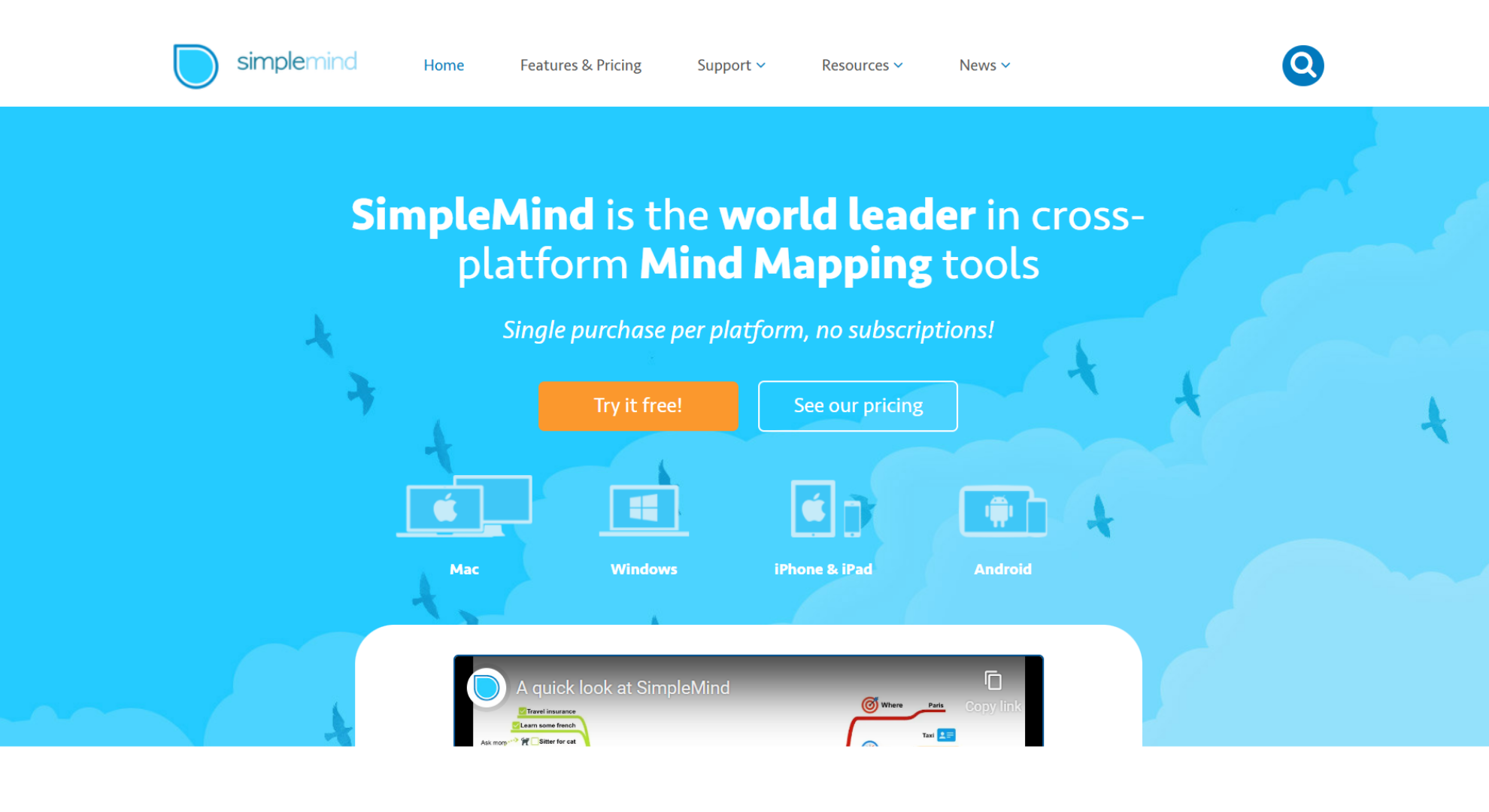
Why it stands out
SimpleMind is a versatile, cross-platform mind mapping tool designed for users who want offline-first, distraction-free mind mapping without subscription constraints. Unlike VisualMind, which emphasizes AI-powered automation and online features, SimpleMind focuses on simplicity, flexibility, and total control over your maps. Users can create free-form maps, moving topics anywhere on the canvas, or use auto-layouts for quick structured diagrams. Its clean interface and intuitive workflows make it easy for students, professionals, and creatives to organize ideas without a steep learning curve.
SimpleMind supports cross-platform use across Mac, Windows, iOS, and Android, allowing seamless access to your maps whether at home, in the office, or on the go. Export options include PDF, images, and more, enabling sharing or embedding into documents and presentations.
Key features
Free-form and auto-layout mind mapping for flexible organization.
Cross-platform support: Mac, Windows, iOS, Android.
Export to PDF or share via files.
Customizable nodes with colors, icons, notes, and images.
Offline use on all supported devices.
Pros
One-time purchase model ensures long-term access without recurring fees.
Clean, intuitive interface suitable for beginners and pros alike.
Works completely offline across all supported devices.
Supports structured and free-form brainstorming.
Cons
No AI-powered automation or idea generation.
Collaboration tools are limited for team projects.
Fewer advanced features compared to AI-first alternatives.
Pricing
Mobile app: $6.99 (one-time purchase)
Desktop app: $29.99 (one-time purchase)
5. Inspiration
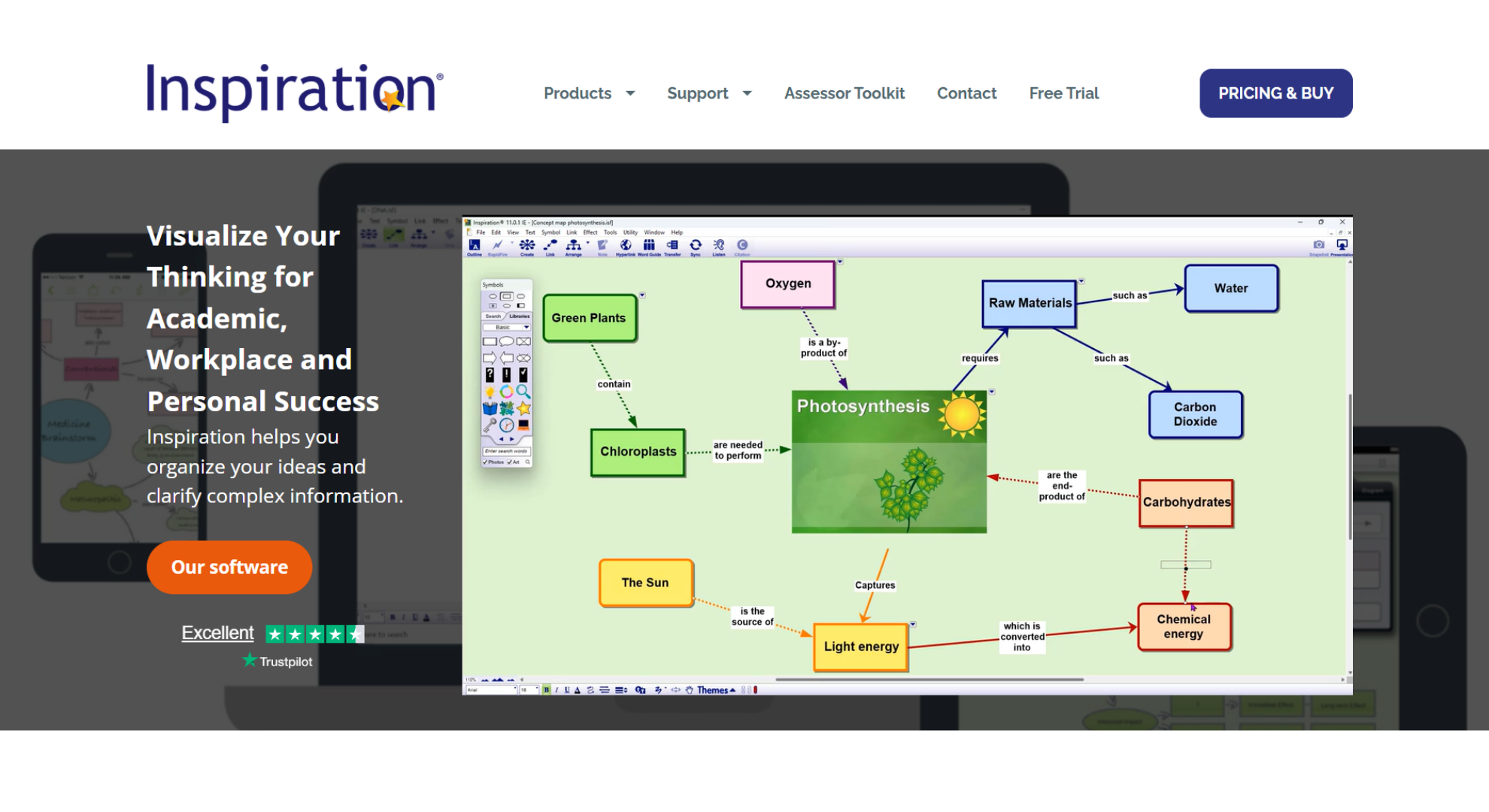
Why it stands out
Inspiration is a learning- and education-focused mind mapping tool that combines mind maps, concept maps, and outlines within a single, intuitive workspace. Unlike VisualMind, which emphasizes AI-generated maps and interactive workflows, Inspiration focuses on structured thinking, memory retention, and teaching-friendly features. Its dual desktop (Inspiration 11) and cloud (Inspiration RD) versions make it flexible for both offline classroom environments and online learning on Mac or Chromebook.
The platform is especially well-suited for students, educators, and trainers who need tools for lesson planning, essay writing, and concept organization. With a large library of templates, guided tutorials, and assistive technology support (DSA/AtW), Inspiration helps users quickly grasp concepts and create visually clear diagrams without a steep learning curve.
Key features
Desktop version (Inspiration 11) for offline use.
Cloud-based RD version for Mac and Chromebook.
One-time perpetual licenses for single users or institutional deployments.
Templates, guided tutorials, and lesson planning tools.
Supports concept maps, outlines, and mind maps in a single workspace.
Pros
One-time purchase model no recurring subscription required.
Education-oriented features tailored for teaching and structured learning.
Beginner-friendly templates and guides for quick adoption.
Compatible with assistive technology for accessibility.
Cons
No AI-assisted mind mapping or automation.
Collaboration features are limited, with minimal cloud support for multi-user editing.
UI feels slightly dated compared to modern AI-powered tools.
Pricing
Single-user license: One-time purchase (regional pricing may vary)
Organization/site licenses: Available for schools, universities, and institutions
6. Novamind
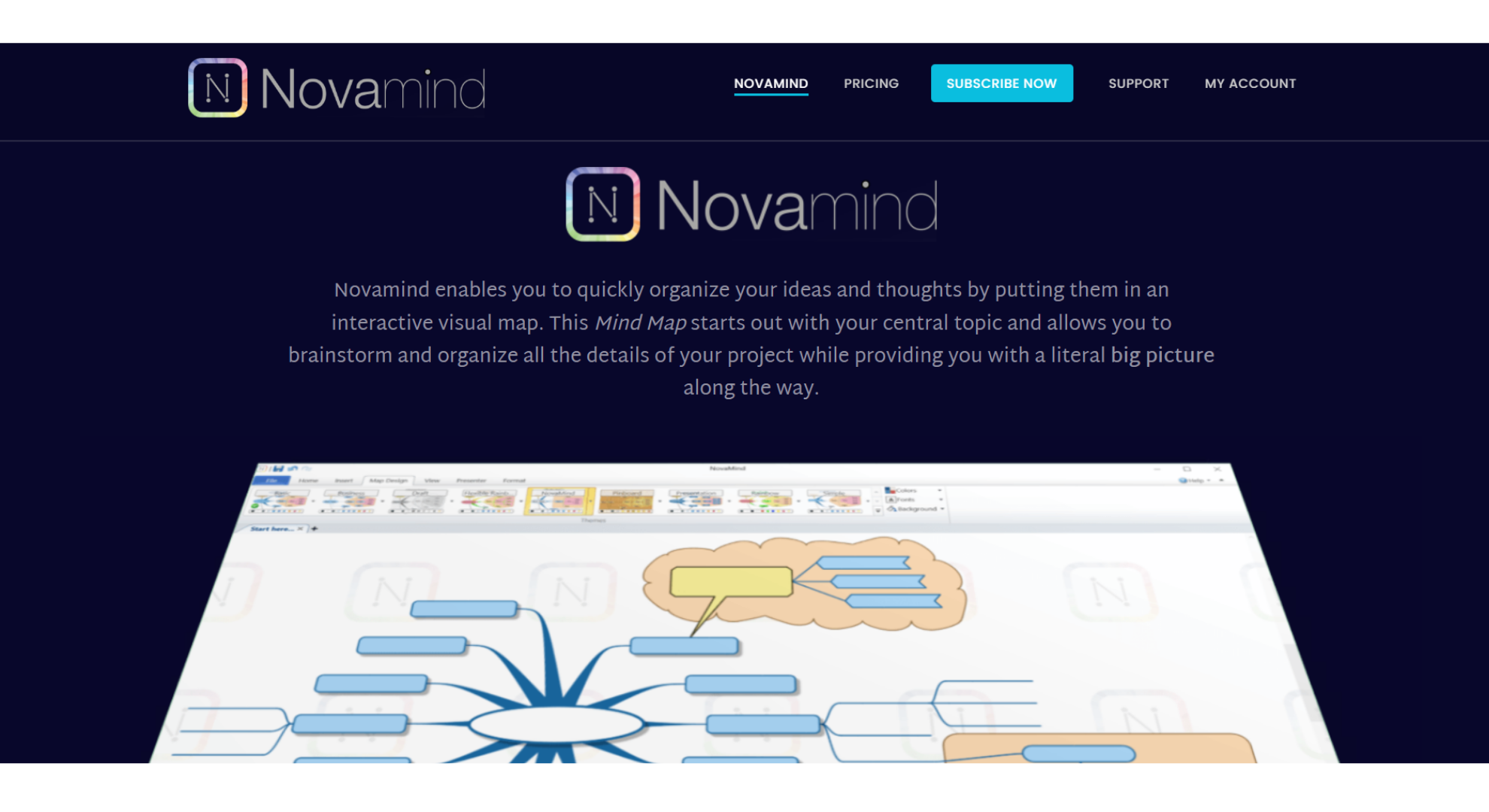
Why it stands out
Novamind is a classic, offline-first mind mapping tool designed for users who prioritize simplicity, speed, and distraction-free workflows. Unlike modern AI-powered alternatives like VisualMind, Novamind keeps everything local, with a drag-and-drop interface that allows users to create clean visual maps without the need for cloud services. Its lightweight approach makes it ideal for solo users, educators, or small teams who don’t require collaboration or AI-assisted features.
Even though its cloud services have been discontinued, Novamind’s focus on offline map creation, outlining, and basic presentations ensures that users can continue working in stable environments without connectivity concerns. Its legacy desktop installers support Windows and older macOS versions, making it a reliable option for users with legacy systems.
Key features
Quick visual map creation with drag-and-drop interface.
Desktop-only, fully offline functionality.
Supports basic diagramming, outlining, and slide presentations.
Legacy installers available for Windows and older macOS systems.
Pros
Minimal learning curve, suitable for beginners and solo users.
Fully offline: no internet connection required.
Lightweight, distraction-free workspace for focused mapping.
Cons
Cloud service discontinued, limiting modern collaboration options.
No AI-assisted features or automation.
Aging interface compared to newer AI-powered or web-based tools.
Pricing
One-time desktop purchase (availability depends on legacy installer support).
Find the perfect match for your workflow
Comparison at a Glance
| Tool | Entry Price | AI Quota | Stand-out Strength |
|---|---|---|---|
| MindMap AI | From $3.74/mo (yearly) | 2,000–5,000 credits/mo | AI-powered file-to-map + Copilot Chat |
| Xmind | $79/year | – | Cross-platform mapping with Gantt charts |
| MindNode | $3.99/mo | – | Apple-centric, focus mode & outline workflow |
| SimpleMind | $6.99 mobile, $29.99 desktop | – | Offline, intuitive cross-platform mapping |
| Inspiration | One-time license | – | Education-focused mapping with templates |
| Novamind | Legacy one-time purchase | – | Offline, lightweight mapping |
FAQ
Q: Why is MindMap AI the best alternative to VisualMind?
A: MindMap AI takes AI-powered mind mapping to the next level by allowing users to generate structured maps instantly from files such as PDFs, videos, audio, images, and CSVs. Unlike VisualMind, which relies mainly on chat prompts, MindMap AI’s Copilot Chat and Second-Order Connections enable deeper analysis, real-time refinement, and smarter idea linking making it more versatile for research, education, and project planning.
Q: Is Inspiration a good VisualMind alternative for educators?
A: Inspiration remains an excellent tool for students and teachers, especially for creating structured lesson plans and concept diagrams. But it doesn’t support AI automation or multi-format input. MindMap AI enhances the educational experience by allowing users to upload lectures, PDFs, and notes to create instant mind maps making study and lesson preparation much faster and smarter.
Q: Are AI-generated maps editable in MindMap AI?
A: Absolutely. MindMap AI creates fully editable mind maps, allowing users to manually adjust nodes, colors, positions, and hierarchy. You can also use Copilot Chat to further expand or simplify branches interactively, offering the best balance of automation and human control.
Q: What is the most affordable VisualMind alternative for individuals?
A: For individuals and students, MindMap AI’s Basic plan ($3.74/month billed annually) offers exceptional value, providing 2,000 AI credits, free manual maps, and export options. It’s significantly more powerful than VisualMind’s limited free version while remaining affordable.
Final Takeaway
VisualMind offers an engaging AI-assisted approach to learning and idea generation. However, the top VisualMind alternatives in 2025 provide even greater versatility, supporting complex workflows, multiple input formats, and advanced collaboration features.
MindMap AI is one of the most powerful alternatives available. It can convert PDFs, videos, audio, text, CSVs, and images into detailed, editable mind maps in seconds. With intelligent tools like AI Expand, Summarize, and Focus Topic, it enables users to explore ideas deeply, generate insights, and organize information intuitively. Exporting in multiple formats (PDF, PNG, SVG, Markdown) and real-time syncing across devices make it ideal for individuals, educators, and teams alike.
If you’re looking for a more comprehensive and flexible AI-powered solution, MindMap AI is the ultimate alternative to VisualMind in 2025.




